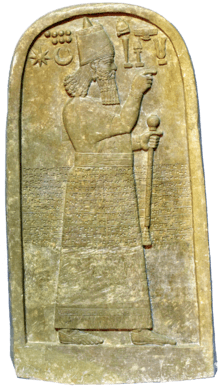Ninurta-apal-Ekur
Ninurta-apal-Ekur, inscribed mdMAŠ-A-é-kur,[1] meaning “Ninurta is the heir of the Ekur,”[2] was a king of Assyria in the early 12th century BC who usurped the throne and styled himself king of the universe and priest of the gods Enlil and Ninurta.[3] His reign is immensely significant to the Chronology of the ancient Near East as it overlaps the reigns of his Babylonian contemporaries Adad-šuma-uṣur and Meli-Šipak.
| Ninurta-apal-Ekur | |
|---|---|
| King of Assyria | |
| King of the Middle Assyrian Empire | |
| Reign | 1182–1180 BC |
| Predecessor | Enlil-kudurri-usur |
| Successor | Ashur-dan I |
| Father | Ilī-padâ |
Biography
There is some dispute as to how long he reigned, based on discrepancies among various copies of the Assyrian King List. The Nassouhi King List,[4] sometimes considered to be older than the other versions of the King List we have, gives him 13 years of reign, but the other king lists give him only three. More recent scholarship has tended to support the shorter reign, in which case he reigned from 1182 to 1180 BC (alternately, he reigned from 1192 to 1180 BC).
There are up to eleven possible limmu officials named for his regnal years and a recent publication proposes the following sequence:
- Salmanu-zera-iqiša
- Liptanu
- Salmanu-šumu-lešir
- Erib-Aššur
- Marduk-aḫa-eriš
- Pišqiya
- Aššur-dan I
- Atamar-den-Aššur
- Aššur-bel-lite
- Adad-mušabši
As the seventh in the sequence is Ninurta-apal-Ekur's son and successor, Aššur-dan I, and the king was thought to occupy the limmu position in the first year of his ascendancy, it is suggested that the succession took place here.[5]
His provenance
His father was Ilī-padâ,[6] who had followed his father, Aššur-iddin, and grandfather, Qibi-Aššur, as grand vizier, or sukkallu rabi’u, of Assyria and king of the dependant state of Ḫanigalbat.[7] Qibi-Aššur may be one of three officials who are attested as limmu’s, the sons of Šamaš-aḫa-iddina, Ṣilli-Marduk, Ibašši-ili, respectively and it is this latter one, whose limmu year directly follows that of Tukulti-Ninurta I, that has led some to speculate that Ninurta-apal-Ekur was a descendant of Adad-nirari I, a genealogy that is unlikely as he claims descent only from Eriba-Adad I in his inscriptions. The earlier two have their limmu years during the reign of Shalmaneser I which better fits the chronology.
His ascendancy
The preceding Assyrian king, Enlil-kudurri-usur, a son of the earlier powerful king Tukulti-Ninurta I, was vanquished in battle against the Kassite monarch, Adad-šuma-uṣur, a defeat so ignoble that the Assyrian officers “seized [Enlil-kudu]r-usur their lord and gave (him) to Adad-šuma-uṣur.”[8] Perhaps to secure their passage, the Assyrians also handed over renegade Babylonians who had fled to the Assyrian side.[8]
While these events were unfolding, “Ninurta-apal-Ekur went home. He mustered his numerous troops and marched to conquer Libbi-ali (the city of Aššur).”[9] The Kings List tells us that he “came up from Karduniaš, seized the throne,”[6] although it can only be speculated what he was doing in Karduniaš (Babylonia). The Synchronistic Chronicle continues “But [...] arrived unexpectedly, so he turned and went home”[9] which suggests that the succession was not smooth.
Ninurta-apil-Ekur is said to have "guarded all the people of Assyria, with wings like an eagle spread out over his country.[10] He was the recipient of gifts from Meli-Šipak, who sent teams of horses and rugs, as a recently discovered text records, unearthed during excavations at Assur.[11]
Palace decrees
He issued nine palace decrees relating to conduct of the court and the oppressive discipline of the royal harem, suggestive of insecurity in the succession, although he need not have worried as his descendants would continue to rule Assyria until at least the eighth century BC. The first relates to the conduct of a eunuch approaching the harem and that of the concubines. The second threatens the harem women with having their throats cut, if when quarreling they should blaspheme against a god. The third punished men guilty of lèse majesté and the remaining are too fragmentary to be certain of their contents, but regulate curses against, for example, the royal furniture, i.e. bed and stool. Minor infractions were dealt with severely, with the guilty woman having her nose pierced and being beaten with rods.[3]
A text records his gift of jewelry to his daughter Muballita[ṭ-...], the great high priestess.[3]
References
- Kyle R. Greenwood (2010). "A Historical and Contextual Reconstruction of KAH 2.76". Nouvelles Assyriologiques Bréves et Utilitaires (NABU) (2): 45.
- A. K. Grayson (2001). Erich Ebeling; Bruno Meissner; Dietz Otto Edzard (eds.). .Reallexikon der Assyriologie und Vorderasiatischen Archäologie: Nab – Nuzi. Walter De Gruyter Inc. p. 524.
- A. K. Grayson (1972). Assyrian Royal Inscriptions, Volume I. Wiesbaden: Otto Harrassowitz. pp. 139–141.
- Nassouhi King List = Assyrian King List A
- Jaume Llop (June 2008). "MARV 6, 2 und die Eponymenfolgen des 12. Jahrhunderts". Zeitschrift für Assyriologie und vorderasiatische Archäologie. 98 (1): 20–25.
- Assyrian King List, “Ninurta-apil-Ekur, son of Ila-Hadda, a descendant of Eriba-Adad, went to Karduniaš. He came up from Karduniaš, seized the throne and ruled for A13/B+C3 years.”
- Itamar Singer (2006). "KBo 28.61-64, and the struggle over the throne of Babylon". Ḫattuša-Boğazköy. Gernot Wilhelm. pp. 224, 237.
- C.B.F. Walker (May 1982). "Babylonian Chronicle 25: A Chronicle of the Kassite and Isin II Dynasties". In G. van Driel (ed.). Assyriological Studies presented to F. R. Kraus on the occasion of his 70th birthday. Netherlands Institute for the Near East. pp. 398–406.
- Synchronistic Chronicle (ABC 21), tablet B, column 2, lines 5 to 8.
- Donald John Wiseman (1965). Assyria and Babylonia, c 1200-1000 BC, Volume 2, Part 31. Cambridge University Press. p. 11.
- Eckart Frahm. "Inscribed objects". Retrieved October 2, 2011.
| Preceded by Enlil-kudurri-usur |
King of Assyria 1182–1179 BC |
Succeeded by Ashur-dan I |
